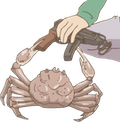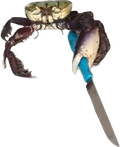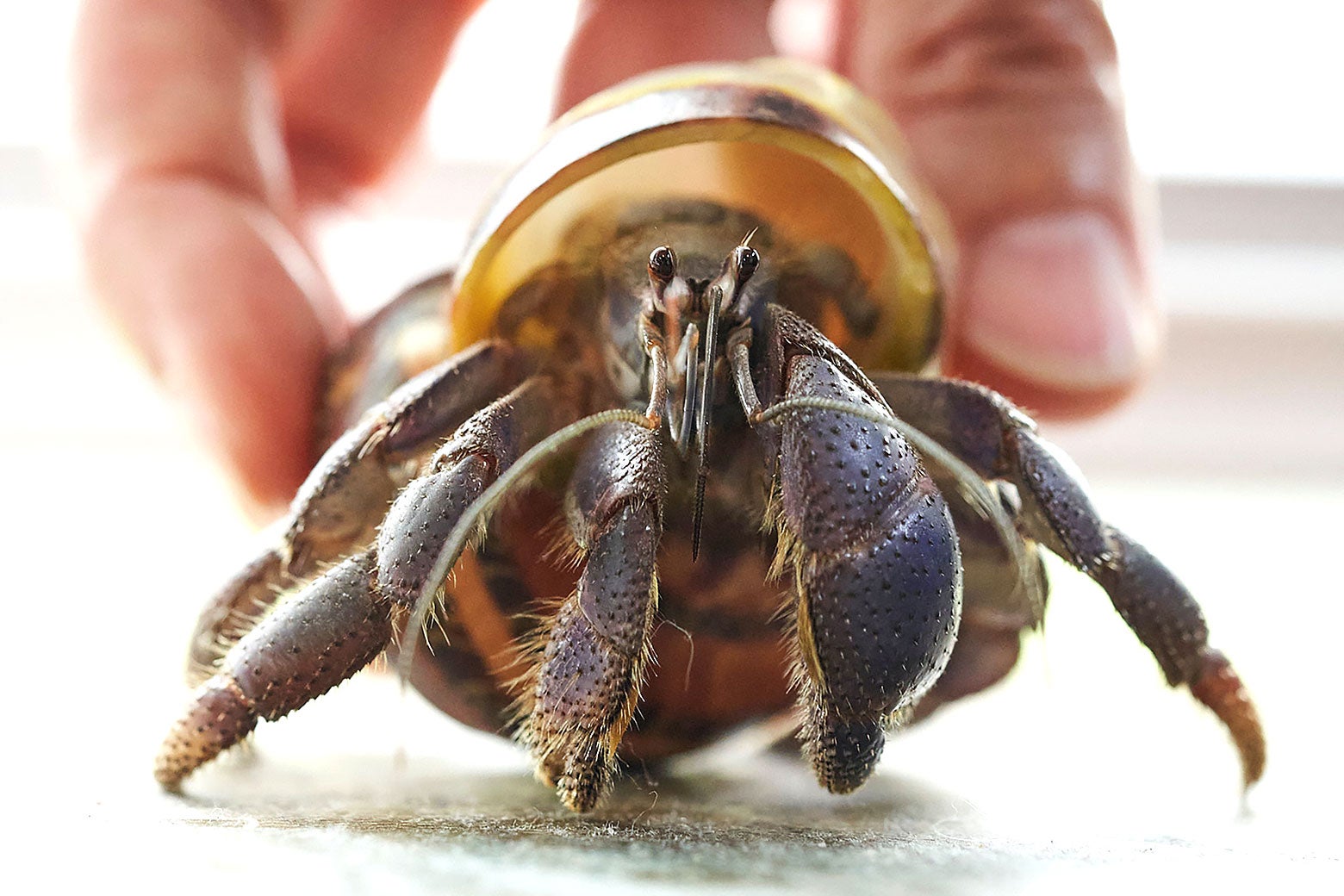For you, a hermit crab’s lifespan is measured in months. Your kid picks one out at a beach souvenir shop. Its shell is painted to resemble SpongeBob’s freckled face. Dutifully, you buy accessories. To the shoebox-sized tank, you add some sand, a plastic palm tree, a little dish of water with a sponge, and a sprinkling of food pellets.
The crab proves an unsatisfying pet. It barely moves. It curls into its shell when you approach. One day, there is a smell.
Hermit crabs have long been billed as low-maintenance animals, the harried parent’s alternative to a hamster. They were first sold in the U.S. to tourists at a souvenir shop in West Palm Beach, Florida, in 1953, according to Larisa Meeks, a self-described crab advocate (one of many I’d meet over the course of reporting this story). The popularity of the hermit crab as a pet soared in the 1970s, when one company branded them “Crazy Crabs” and told buyers they would eat anything: pizza, cookies, cornflakes! “Consider these moving Pet Rocks,” a pitchman said on TV.
On a recent vacation to North Carolina’s Outer Banks, I asked the manager of a beach shop what the crabs needed. “Just food and water. Don’t need to take them for a walk, nothing.” How long do they live? He had heard of one that lasted seven years, but “you never know,” he said. “One year, one week, one month.”
Few people know the truth about the crustacean that briefly resides in their child’s bedroom: that it was meant to live for at least 30 years. That it was taken from the wild. And that it was doomed even before you brought it home.
This quiet tragedy of the dead-before-its-time hermit crab repeats itself over and over every summer. If it’s ever going to stop, crab advocates say, we need to reconsider everything we know about these creatures.
On a bright July weekend, hermit crab enthusiasts descend on the lodge in the Virginia mountains where Dirty Dancing was filmed. They’ve traveled from all over the East Coast and Midwest to attend Crab Con, also known as the International Annual Hermit Crab Convention.
People dance in crab hats and buy custom-embroidered crab jean jackets. Meeks wears a T-shirt that reads “Hermit Crabs and Jesus.” There are lengthy talks on shell selection, crab taxonomy, and veterinary care (though vets who treat crabs are few and far between). Meeks hosts a showcase of crab enclosures.
Most people here share the same story: They casually bought a crab. They learned, too late, what they had done. Then they joined the cause.
In 2003 Stacy Griffith purchased two crabs from a mall pet shop in Illinois. She set up a small tank exactly like the one in the store: “the 10-gallon tank with the gravel, the sponge, the pellets. And one of them died almost immediately. And I was like, ‘Well, that doesn’t seem right.’ ”
Griffith searched online for answers. She found the Hermit Crab Association, a volunteer-operated message board that today has more than 250,000 posts. She also found the Crab Street Journal, a site that got its start as a Yahoo Group back in 1999.
These vast archives of crab lore contradicted everything the pet shop had told Griffith. She learned that hermit crabs’ special needs and extraordinary longevity make them pets akin to a Sulcata tortoise or a parrot. (One, named Jonathan Livingston Crab, lived for 45 years after his keeper, Carol Ann Ormes, bought him in Ocean City, Maryland, in 1976.) Years after her first crab’s untimely death, Griffith, now president of the Land Hermit Crab Owners Society, would go on to write her own book on crab care, which is aimed at “changing the mindset” around the species’ keeping.
Virtually everything we know about the needs of captive hermit crabs has come from the efforts of passionate hobbyists. Formal science is not invested in the inner life of the pet crab the way it is with dogs, or even hamsters. Many studies on hermit crab physiology date to the 1970s and ’80s, notes Noah Goldfarb, a veterinary student in his final year at the Virginia-Maryland College of Veterinary Medicine who has kept crabs since he was a kid. As a result, even veterinarians may rely on the husbandry guidelines developed by the community of serious crab keepers. “That data is the best that people have,” said Goldfarb.
A proper hermit crab habitat—a “crabitat”—is large. A 3-foot-long, 40-gallon tank would be the minimum for four crabs, which are social animals that shouldn’t be kept alone. It should contain moist sand mixed with coconut fiber, at least 6 inches deep so the crabs can bury themselves when they need to molt and regrow their exoskeleton (an arduous and private process). It includes a small pool of fresh, unchlorinated water and another of specially formulated salt water, both deep enough for full submersion. A heater on the side of the tank keeps the temperature stable between 75 and 85 degrees. A high-quality gauge monitors humidity, which should remain between 70 and 80 percent. In essence, you’re creating a tropical coastal forest in a box. Pet stores stock many of the supplies needed to do this—but they also sell teensy enclosures that they claim your crab “will feel perfectly at home in.”
This is not accurate. The temperature and humidity guidelines aren’t merely for crabs’ comfort, Goldfarb clarifies: They “are extremely vital to keeping the crabs alive.” Hermit crabs breathe through modified gills; these gills require high humidity to stay moist, allowing them to absorb oxygen from the air. They’re ectotherms, whose body processes function only at certain temperatures. And crabs need that deep substrate to safely molt, or they risk being eaten by a hungry tankmate.
In the wild, hermit crabs are foragers and scavengers, eating a tropical buffet that might include dead fish, fresh fruit, and even dog droppings, Shawn Miller, a naturalist and photographer on the Ryukyu Islands in Okinawa, Japan, told me. (Miller documents how hermit crabs in the wild are adapting to pollution and habitat loss by living in pieces of plastic instead of regular shells.) Crab pellets sold at pet stores aren’t enough, enthusiasts insist. The Crab Street Journal’s list of recommended foods for captive crabs is startlingly diverse: shrimp, worm castings, moss, acorns, oatmeal, peanut butter, eggshells, flower petals.
Wild hermit crabs are active animals, rummaging through washed-up debris and even climbing trees in their search for food. In captivity, they exercise on angled plastic wheels. Serious crab keepers install a second story to their tank, called a topper, that functions as a playground. They add rope ladders, balconies, plastic plants, even tiny disco balls (crabs love mirrors).
Some people surrender entire rooms to their crabitats, spending thousands of dollars. An outsider might wonder why. What is the allure of hermit crabs?
Many keepers say they just love watching them. A crabitat is kind of like a dollhouse with living inhabitants, each with a distinct personality. The more elaborate the setup, the more active the crabs become, climbing, crawling, and exploring with their endlessly questing antennae.
In the wild, they live in colonies. A group will forage together, with younger crabs following the older ones and even riding on their backs. Sometimes, as has been documented in a BBC series narrated by David Attenborough, they swap shells in a conga line, in which each crab puts on a shell discarded by a larger companion.
They have a pecking order. Bigger crabs defend resources by donkey-kicking smaller ones, sometimes rolling them like a bowling ball, crab keeper Holly Suddeth tells me. But they also sleep peaceably side by side, she says. Another crab keeper, Mary Akers, once witnessed a crab stuck in a tight spot chirping until a friend came to rescue it.
They have opinions about real estate. A hermit crab will inspect a shell with care, running antennae and claws over its contours, before delicately lowering its rear end into the aperture. One researcher found that crabs actually remodel shells, sculpting the interior to make their home lighter and more comfortable. A crabitat should have a variety of shells for the crabs to choose from.
They’re curious. They regard their own reflections, crab keepers say, and there are even anecdotes about crabs who like watching TV. Chip, a crab in Suddeth’s care who’s about 20 years old, will kick out one leg when a human waves to him. Is it a greeting? A challenge? It’s hard to say.
As charming as the crabs can be, many of their keepers are driven by a deeper sense of mission, which Suddeth characterizes as “defiance and righteous rage.”
She lives in Chesapeake, Virginia, close to the resort areas in Virginia Beach and the Outer Banks. There’s a grim local joke that “it’s a rite of passage for children to slowly kill a hermit crab,” Suddeth said. On local moms’ forums, she posts impassioned pleas: Say no when your kid asks for a crab. Every time, she receives pleas in return: Could you take my kid’s crab?
Often, she obliges. Suddeth has rescued more than 100 hermit crabs. Some she keeps. Some she adopts out. Some have been trapped too long in a cold, dry tank. For them, all she can do is provide hospice care.
She tears up when she talks about “these cool little creatures having their whole worlds turned upside down and never being able to go home.”
The SpongeBob crab your kid picked up on vacation is known as a purple pincher (Coenobita clypeatus), a species that’s one of two harvested for the U.S. pet trade. It was collected from a Caribbean coastline and shipped to the U.S. to be sold. (The species is also native to Florida, where it’s illegal to catch them.)
A 2015 investigation by People for the Ethical Treatment of Animals documented the practices at one hermit crab supplier in Orlando, Florida, where thousands of crabs were packed into pens. Their protective shells were broken open with a vise so they could be coerced into the painted shells that appeal to kids. (Sometimes, crab rescuers report, the still-damp paint adheres to the crab’s body, rendering it unable to crawl out of that shell. Suddeth recently took in one of these stuck crabs and managed to extricate it after a long soak.)
The president of that supplier, Don Salomon, told the Wilmington StarNews that the crabs were crowded only because he had picked up an extra shipment at the airport that day. He said some crabs’ shells had been cracked for their own safety because they were not positioned correctly in the shell. (Cracking a shell risks injuring the animal and should never be done except in “exceptionally rare” circumstances, Goldfarb says. Crabs will move to another shell on their own if needed.)
“If we were killing animals, we’d never be making any money,” Salomon told the Daily Mail Online in coverage of PETA’s investigation. After the video’s release, PetSmart stopped doing business with the supplier, the Mail reported.
Whether these practices are typical is hard to say. What care protocols do other hermit crab dealers follow? I contacted three wholesalers to ask but got no response. How many hermit crabs are collected? No industrywide statistics exist. In 2000 the New York Times reported that one of the leading wholesalers, Shell Shanty, sold more than 1 million a year. Paul Manger, the owner of another large wholesaler, Florida Marine Research, told a pet industry magazine in 2017 that his company carried about 300,000 crabs for retail distribution.
Crabs kept in poor conditions before purchase may still succumb to disease, stress, or injury even if their buyer provides ideal conditions, Goldfarb says. “The phenomenon often referred to as ‘post-purchase death syndrome’ is well documented among hermit crab hobbyists, and at least one scientific paper speculates on potential causes,” he wrote in an email.
Even if treated with care, the hermit crab at that beach shop remains a wild creature that was plucked from its home. If crabs are to be kept as pets, crab advocates say, they should be bred in captivity. It’s exceedingly hard to do that. But one woman may have cracked the code.
Mary Akers never intended to become a hermit crab midwife. She’s a writer, a ceramicist, and a naturalist who once co-founded a marine ecology school in Dominica. When she adopted a single pet-shop crab from a friend’s daughter, Akers approached its care with a scientist’s rigor.
She learned that hermit crabs needed friends, so she purchased some neglected crabs from a local pet store. When she spotted a mysterious mass inside one crab’s shell, she realized that it was a clutch of eggs.
For decades, it was believed that crabs never reproduced in captivity. They just didn’t have the right conditions, Akers explained. Once care standards improved, some crabs began to mate and produce eggs—but these didn’t develop properly. While a few successful experiments had been reported by hobbyists in Australia and Germany, details were scanty.
Reproduction is a delicate, multiphase process. Crabs mate on land. The female carries the fertilized eggs for about 30 days. Then she releases them into the sea, where they hatch almost immediately into tiny, shrimplike creatures called zoae.
When Akers spotted the cloud of zoae in her tank’s saltwater pool, she wondered: What did they need to survive?
No one really knew. Not even American University professor Christopher Tudge, an Australian who’s regarded as the world’s foremost expert on hermit crab reproduction. Tudge selected this specialty precisely because it is so understudied. “I said to myself, What’s a group that no one’s interested in? It was the hermit crabs and their relatives.”
In the wild, hermit crab zoae drift with the currents, feeding on smaller plankton. They molt multiple times, eventually becoming something less shrimpy and more lobsterlike, called a megalopa. They find diminutive shells on the ocean floor. “And then they literally walk out, like you would from a swim onto the beach, and never go back,” Tudge said.
The difficulty with mimicking this process, he said, is that “the ocean is, by nature, chaotic.” It’s turbulent. It’s teeming with life. That’s a rich, complex habitat for a teeny baby crab.
To have a shot at keeping the zoae alive and thriving, Akers said, “I had to re-create the ocean”—in her house in Lockport, New York, 500 miles from the Atlantic.
Using 5-gallon water jugs, Akers fashioned rotating tanks to mimic ocean currents. (Aquarists call these Kreisel tanks.) She fed the zoae live phytoplankton and brine shrimp. She hovered over the tanks, siphoning out the debris that fouled the crabs’ nursery and changing the water multiple times a day. Once the zoae became megalopae, they had to be moved to a flat-bottomed tank, then ushered onto land.
None survived Akers’ first attempt in 2017. The next year, she spotted more zoae, and again tried to keep them alive. This time, the ant-sized crabs donned their tiny shells, walked up a ramp, and began to breathe. She wept.
Two made it through their first molt. Akers’ third try, later that year, resulted in 204 baby hermit crabs. The previous world record for the species was, according to Akers, 24 crabs raised by a German hobbyist.
When Tudge stumbled on Akers’ blog detailing this process, he was astonished. “Oh my God,” he recalled on an episode of Radiolab. “She actually did it.” Akers had not only managed to replicate the natural process—she was achieving survival rates far higher than in the wild. “So she’s actually improving their chances by raising them in captivity,” he said.
Akers now had to find homes for these babies. In 2019 she founded Crab Con to give people the first-ever chance to adopt captive-bred crabs. Those adopters agreed to track their crabs’ growth and share data with her. So far, Akers has raised around 1,500, now living as far away as California, Nevada, Arizona, Florida, Texas, and Utah. They seem to be healthy and well adapted to captivity.
Akers estimates she has spent $50,000 on her efforts over nine years, including the cost of a generator, which can keep the system running during a power outage. She never takes a summer vacation, because each spawn requires around-the-clock care for more than a month. Success is not guaranteed. Since moving to Blacksburg, Virginia, from New York in 2021, she has seen decreased baby survival rates. (Her hypothesis: a brown algae infestation. She’s getting new equipment and trying again.)
In 2022 Akers launched a nonprofit, Hermit House, to share what she’s learned and ship zoae to motivated breeders. She hopes someone will devise a better system, one that doesn’t require the constant hovering and hoovering. But even if they do, it’ll never be cost effective when wild crabs sell for a few bucks each.
Their lives are worth so little to some sellers that beach shops simply throw away unsold crabs at summer’s end. “We’ve had people show us pictures of boxes they’ve taken out of the dumpster,” said Griffith, the Land Hermit Crab Owners Society president.
A few hermit crab species are quite valuable, such as the brightly colored blueberry hermit crabs and viola hermit crabs that live in Okinawa. They’re legally protected as living national monuments, yet are frequently poached and sold for hundreds of dollars by people from other countries. New research shows a troubling trend. Over 10 years, the average annual profit from these crabs has more than doubled. The number of crabs sold online has nearly quadrupled, all while the average size of crabs for sale has steadily decreased.
In the U.S., Akers would like to see all hermit crabs legally reclassified as exotic pets, like an alligator or an ocelot, so their sale and ownership could be regulated. To her, every crab’s life is precious. “You have to make people understand and care,” she said, “and the breeding does that.” Captive-bred babies are adorably tiny, with delicate legs and pinprick eyes.
Akers has begun experimenting with intentional crab breeding. She selects for strong coloration, friendliness, and slower growth, “because people love them small,” she explained. One day, perhaps, she might create a crab that’s incredibly well suited to domestication—the golden retriever of hermit crabs, if you will. But are they meant to live in our homes at all?
Crab Con is winding down Saturday afternoon when I realize: I haven’t yet laid eyes on a hermit crab.
It’s hard to maintain the proper conditions in transit, so they’re not ideal road trip companions. But Suddeth, the Chesapeake rescuer, has brought 13 to place with interested adopters. I ask if I can meet one before I go.
Suddeth holds up Pearl, a crab who has lived in captivity for 12 years. Her legs are rosy orange and dusky purple, punctuated by small bumps. Fine lashes fringe her eyes. She emerges from under the veil of her shell, casting about with slender antennae. She seems curious, and unafraid.
“Why are we doing so wrong by this one animal?” Griffith asks. “Why does nobody care about this one?”
Crab advocates have been trying to reform the retail trade for decades. They’ve asked large pet store chains to update how they care for the crabs in store, with mixed success. At least one chain has agreed to place a lid on the crab enclosures to maintain the humidity they need; another has agreed to stop carrying crabs in painted shells.
PetSmart has a hermit crab care page that advises owners to provide enrichment toys, fresh fruit and vegetables, and a crabitat with carefully maintained humidity levels. But the messaging varies: “Hermit crabs are fun, fascinating little creatures that make great pets for your home or classroom. They are easy and economical to care for,” says the description on another PetSmart page. The recommended experience level: beginner. The recommended tank size: 5 gallons per crab (about 16 inches by 8 inches). The price: $6.29.
At a large Outer Banks beach shop, crabs huddle in a wire cage. Attached to the cage is a laminated sheet from supplier Florida Marine Research that notes that crabs should be kept in a large, temperature-controlled aquarium. “NEVER attempt to remove a crab from its sea shell,” the sheet admonishes. Every crab has a painted shell.
“I really think it’s on us to educate each other,” Griffith said. Crabfluencers have become effective allies. Janie Groeling is a New Jersey “hermit crab mom” whose videos have blown up on TikTok. In one, she makes a charcuterie board for her 10 crabs, complete with peach slices, crickets, and octopus, purchased from a specialty site called Hermit Grub. In another, she takes viewers on a tour of her 80-gallon crabitat—one of two tanks in which her hermit crabs live—which is decked out with a climbing wall, a coconut swing, and a “shell shop” with a variety of options for her pets to choose from.
Maybe we should think of hermit crabs the way we think of dogs: animals needing abundant attention that should be adopted, if possible, or at least obtained through a reputable breeder. If you’re willing to dedicate decades to crab care, you could adopt a few rescues—either locally or through the Land Hermit Crab Owners Society qualified adopter program. Or apply to adopt captive-bred babies from Hermit House.
Or maybe they shouldn’t be pets at all. For all their enthusiasm for crabs, this is the view of many crab advocates. Because even the most wonderful crabitat, Griffith said, “cannot replicate the ocean, and the streams, and the trees, and the sand.”
Please, she said: “Let wild crabs be wild.” Maybe one day the cages in the beach shops will be empty. And on your child’s dresser, no crab will meet its end.
when i enact worldwide communism i will ensure that hermit crabs are given more rights than humans. oysters/clams too 
It’s frustrating how people feel free to treat a living thing like a children’s toy, just because it’s not human-like.
Goldfish are another prime example of an animal that is often treated like a disposable object. The horror stories of what people do to them. An animal that can grow to the size of a guinea pig and live for twenty years naturally. They need at least 2 feet of swimming space and a filter. They’re intelligent, they can solve puzzles, they remember faces.You tell people this and they’ll roll their eyes at you like you’re some kind of bleeding heart.
Sorry for the rant but it pisses me off.
I never knew people kept hermit crabs as pets, but nothing about how people treat animals surprises me anymore

I don’t know the origin of it, but the whole ”goldfish memory” myth was surely created to justify treating them so poorly.
I do consider them. They shouldn’t be pets.
There are a lot of “shell shops” along a stretch of road here that sell overpriced boogie boards, overpriced RVCA and Billabong gear, and fucking hermit crabs amongst countless other surfer kitsch. There are giant 12’ round tables with sand, and a shallow depression filled w water to allow for the hermit crabs to have some semblance of a tidal flat. A lot of the shells have goofy fucking designs acrylic painted on to the shells to make them more salable I guess. You can buy those sorta rectangle sorta square acrylic 4x5x4 prisons you can keep them In until they die because they aren’t meant to be anywhere but in the goddamned sea.
I’ve seen multiple shells shops with signs in the hermit crab tanks that say something along the lines of refunding due to death if within X amount of days with proof of purchase. They treat them like slightly more expensive Betta fish basically. It’s depressing, standing amongst the dead sanddollar shells by the hundreds, or the goofy scenes of shells glued together to look like biplanes, or people with googly eyes, or cars. There’s also the baby sharks caught and preserved somehow, so that the body is preserved, but there are no guts, and it weighs next to nothing, almost like they’re freeze dried. Or the puffer fish preserved the same way. And the rays and skates too. Those things are caught with trawl nets or gill nets in tidal areas responsible for breeding more fish. Basically fishes nurseries. And the stupid hanging lamps made of the preserved skins/skeletons of puffer fish caught by the thousands and sold for 79.99
They treat them like slightly more expensive Betta fish basically
Mistreatment of bettas really gets my goat. The whole ‘they can live in puddles in thailand’ doesn’t mean you /should/ keep them in a half litre of unfiltered water in full sun on your work desk. Them being aggressive is also a consequence of having to compete over mating partners and territory
It’s like the whole alpha wolf theory based on animals abused in captivity that then has come to stand in for the whole common understanding of the animal’s social structure
RIP Claude, Pincher, and Krabby - I was heartbroken they only lived a year, but reading this article, that sounds comparatively long in captivity, and a miracle considering I was like 10 years old and the internet didn’t exist yet lol. They’re good critters and deserve better (to not be pets). Same with anoles (ours were named Camille and Leon)
I didn’t know people did this to crabs. What a sad story.
Never, ever get a pet unless you, the parent (children are not able to handle the responsibility), have the time, resources and motivation to learn what your pet needs and provide it.
oh no. My sister had like 10 of these when we were little. Each one died after a couple weeks to a month and she’d go to the pet store and get another.
How terrible.
Thank you, I had no idea. I’ve never had a hermit crab and now I’m considering buying a giant habitat and rescuing all of the little guys I can find.
I can’t believe you’d even consider doing this and not call it a crabitat.
Carnists abuse animals, news at 11.
I have a 30 gallon tank of mostly shrimp - and it’s ~ 100% rate people joke about eating them while expecting me to laugh (I guess?) - but then you talk about grilling their dog and noooooooo not funny
don’t really think this has much to do with whether or not someone is a carnist lol. Vegans live at/go to the beach too and have children who may want a pet or may have been a child who wanted a pet & got a hermit crab at some point in time, believe it or not.
veganism is not a diet https://www.vegansociety.com/go-vegan/definition-veganism
“all forms of exploitation of, and cruelty to, animals for food, clothing or any other purpose;”
Carnism is the ideology which allows people to commodify non human animals. Vegans don’t buy and sell animals because vegans respect their autonomy
I never said veganism was a diet and understand that it encompasses more than just ‘not eating animal products’, that isn’t the point of what I said. It should not be impossible for you to imagine a vegan who has owned a hermit crab as a pet without knowing the largely cruel trade that drives 99% of pet ownership of them.
I’m sure you’ve immediately thought ‘those aren’t actual vegans then’ upon imagining such a scenario, but I think you’re kind of expecting the average vegan to be a lot more staunch about the nuances of animal trade/exploitation/pet ownership than the average vegan (at least the ones I’ve known/spoken to/encountered throughout my life) actually is.
Does a vegan become a carnist if they rescue a stray pregnant dog/cat and adopt away the babies because they can’t afford to raise all of them? I’d say it is cruel to separate a litter of any newborn animal, so should the vegan just give away the pregnant animal? Does a vegan become a carnist if they keep a litter of stray puppies together for multiple years and only adopts them out when they are forced to due to external circumstances? Does that slide and they only become a carnist when one of the adoptees’ has puppies and the person who adopted them sells the puppies?
If a vegan rescues a bunch of hermit crabs from a pet shop and adopts them out to other well-equipped enthusiasts, are they are a carnist? How far does the autonomy of the domestic hermit crab stretch? Should a vegan take all the hermit crabs they’ve purchased from a shitty wire cage in some beach shop and just dump them on the beach? Is it more cruel to try to save the ones from the trade, like the breeder is doing? Surely it must be right, because breeding any captive animal is commodifying them and throwing their autonomy out the window. And yeah, I know the ideal solution is to just ban the sale/trade/ownership of them outright and kill anyone who dares otherwise - but that isn’t realistic at the moment. (All of this is just kinda smuglord reddit-tier discourse but I’m leaving it because I do think it is valid even if it is the shit I know vegans hear 24/7)
Anyways I am not trying to argue or anything - I just don’t think it is fair to say ‘well yeah duh carnists abuse animals news at 11’ in response to an article about hermit crabs, when yeah - the trade of them is exploitative & abusive, so any hermit crab that someone winds up getting as a pet is usually going to be bought but that doesn’t mean every hermit-crab owner is a carnist. I wouldn’t personally label a vegan who had/has a hermit crab (adopted, gifted, or otherwise) a carnist, much like how I wouldn’t necessarily label a vegan who has some Siberian Husky they rescued from a shelter as a pet a carnist (well actually I would if they lived in like Arizona or somewhere really egregious but i digress).
spoiler
I am hitting reply knowing this entire response sounds like an argument but just know I am just yapping not really arguing thank you
It’s completely beside the point of the article, but that one crab’s name is a reference to the short story Jonathan Livingston Seagull. I completely disagree with most of its worldview because it is basically neoplatonist, but I think it’s a very fun and memorable story that is worth reading. It’s sort of like if Alan Watts wrote a very eventful fable, for better and for worse, if that’s a useful point of reference.
Good article, btw
 arm the crustaceans
arm the crustaceansWhat an interesting read!
Edit: also appreciate the DFW nod









